Exercise Physiology: Exercise Impact on Adolescent Well-being
VerifiedAdded on 2023/06/10
|31
|9260
|56
Essay
AI Summary
This essay explores the relationship between exercise physiology and cognitive function in adolescents, emphasizing the opportune phase for cognitive enhancement during this developmental stage. It defines adolescence and puberty, highlighting brain development during puberty and the impact of physical activity on cognitive development. The essay reviews the current trend of decreasing physical activity in schools and discusses the mechanisms of exercise-induced cognitive enhancement, including both acute and chronic pathways. It also addresses the potential ceiling effect of exercise on cognition and considers whether the benefits are limited to specific tasks or individuals. The content aims to provide a comprehensive understanding of how exercise influences cognitive abilities, academic performance, and overall well-being in adolescent schoolboys.
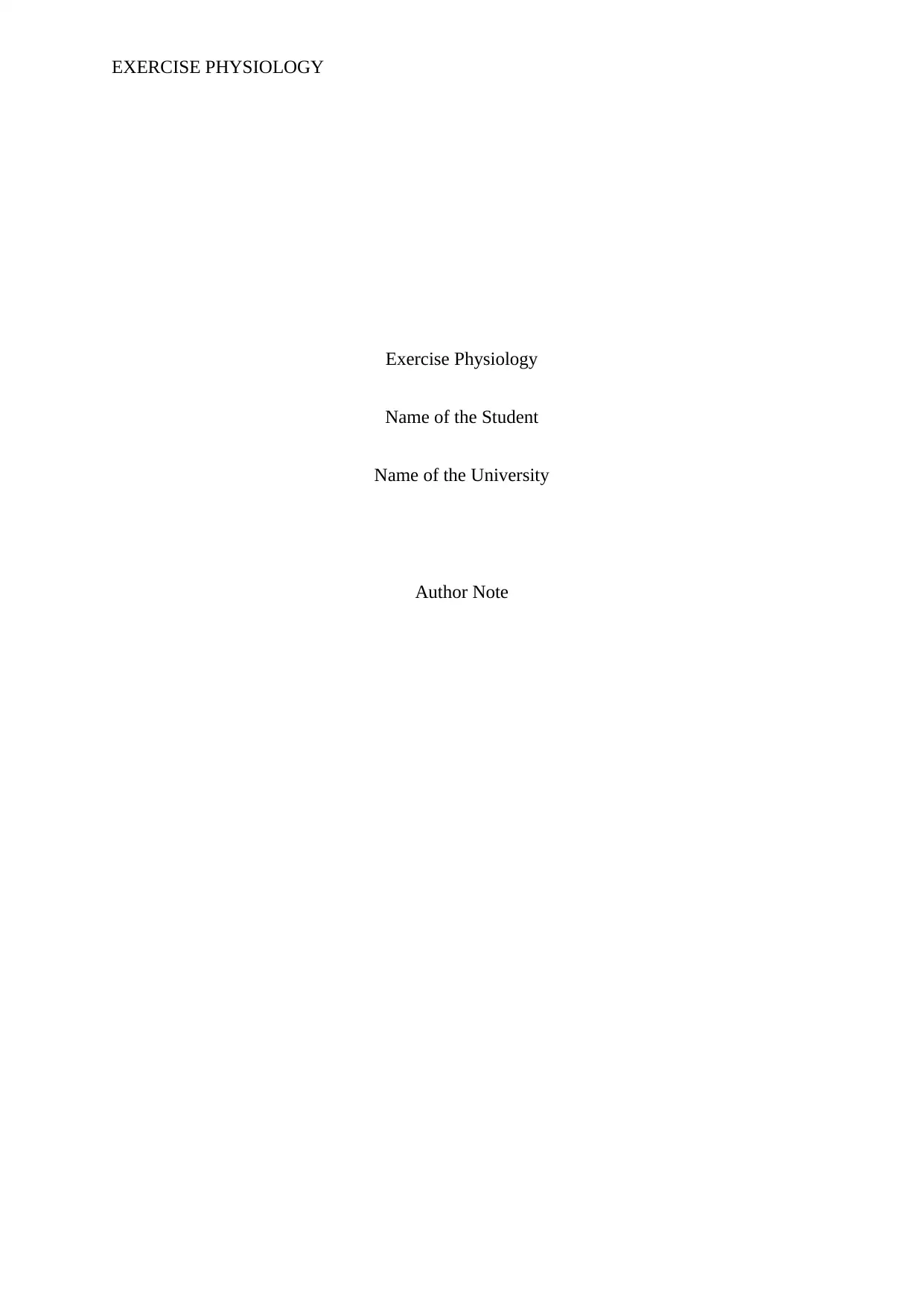
EXERCISE PHYSIOLOGY
Exercise Physiology
Name of the Student
Name of the University
Author Note
Exercise Physiology
Name of the Student
Name of the University
Author Note
Paraphrase This Document
Need a fresh take? Get an instant paraphrase of this document with our AI Paraphraser
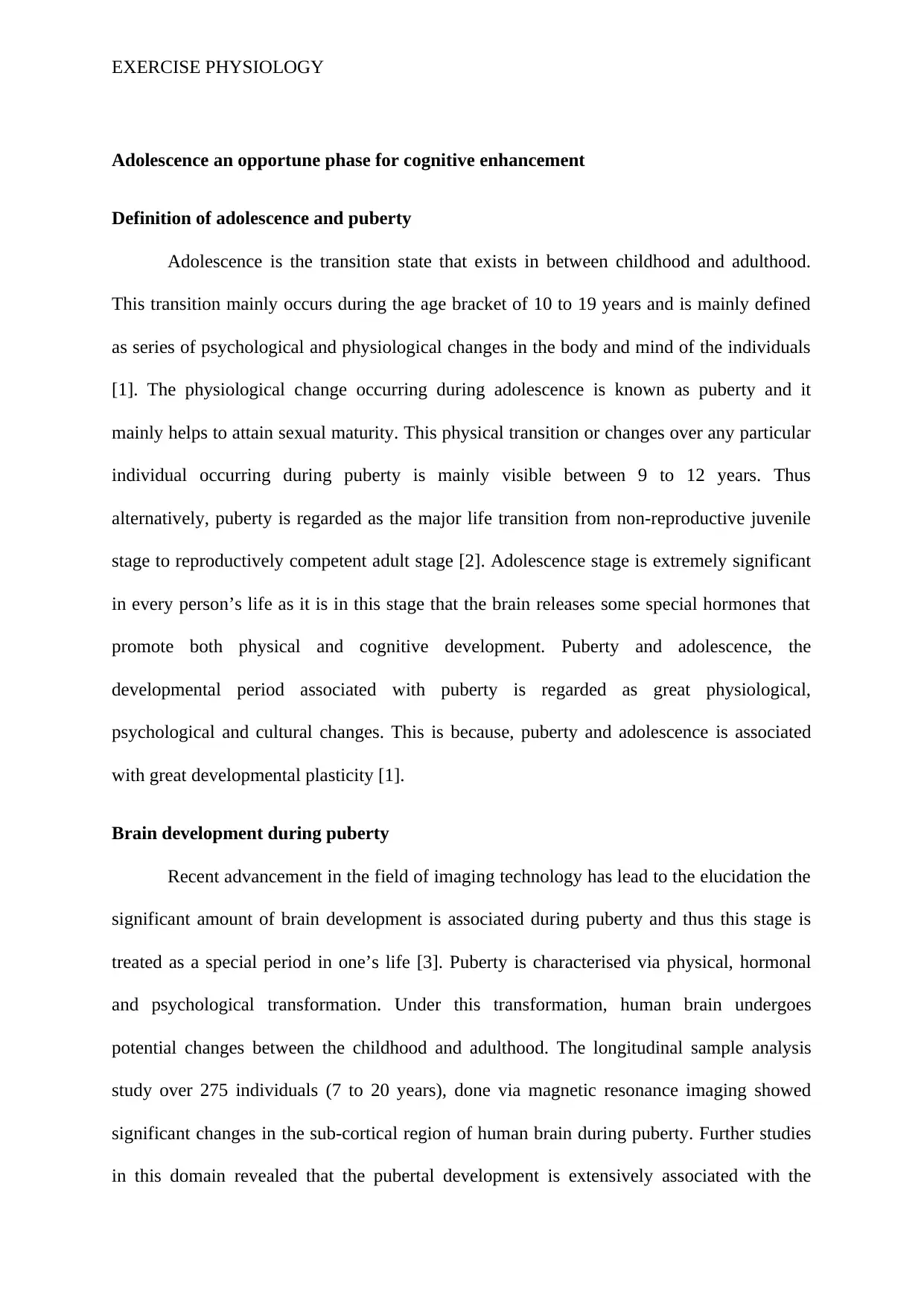
EXERCISE PHYSIOLOGY
Adolescence an opportune phase for cognitive enhancement
Definition of adolescence and puberty
Adolescence is the transition state that exists in between childhood and adulthood.
This transition mainly occurs during the age bracket of 10 to 19 years and is mainly defined
as series of psychological and physiological changes in the body and mind of the individuals
[1]. The physiological change occurring during adolescence is known as puberty and it
mainly helps to attain sexual maturity. This physical transition or changes over any particular
individual occurring during puberty is mainly visible between 9 to 12 years. Thus
alternatively, puberty is regarded as the major life transition from non-reproductive juvenile
stage to reproductively competent adult stage [2]. Adolescence stage is extremely significant
in every person’s life as it is in this stage that the brain releases some special hormones that
promote both physical and cognitive development. Puberty and adolescence, the
developmental period associated with puberty is regarded as great physiological,
psychological and cultural changes. This is because, puberty and adolescence is associated
with great developmental plasticity [1].
Brain development during puberty
Recent advancement in the field of imaging technology has lead to the elucidation the
significant amount of brain development is associated during puberty and thus this stage is
treated as a special period in one’s life [3]. Puberty is characterised via physical, hormonal
and psychological transformation. Under this transformation, human brain undergoes
potential changes between the childhood and adulthood. The longitudinal sample analysis
study over 275 individuals (7 to 20 years), done via magnetic resonance imaging showed
significant changes in the sub-cortical region of human brain during puberty. Further studies
in this domain revealed that the pubertal development is extensively associated with the
Adolescence an opportune phase for cognitive enhancement
Definition of adolescence and puberty
Adolescence is the transition state that exists in between childhood and adulthood.
This transition mainly occurs during the age bracket of 10 to 19 years and is mainly defined
as series of psychological and physiological changes in the body and mind of the individuals
[1]. The physiological change occurring during adolescence is known as puberty and it
mainly helps to attain sexual maturity. This physical transition or changes over any particular
individual occurring during puberty is mainly visible between 9 to 12 years. Thus
alternatively, puberty is regarded as the major life transition from non-reproductive juvenile
stage to reproductively competent adult stage [2]. Adolescence stage is extremely significant
in every person’s life as it is in this stage that the brain releases some special hormones that
promote both physical and cognitive development. Puberty and adolescence, the
developmental period associated with puberty is regarded as great physiological,
psychological and cultural changes. This is because, puberty and adolescence is associated
with great developmental plasticity [1].
Brain development during puberty
Recent advancement in the field of imaging technology has lead to the elucidation the
significant amount of brain development is associated during puberty and thus this stage is
treated as a special period in one’s life [3]. Puberty is characterised via physical, hormonal
and psychological transformation. Under this transformation, human brain undergoes
potential changes between the childhood and adulthood. The longitudinal sample analysis
study over 275 individuals (7 to 20 years), done via magnetic resonance imaging showed
significant changes in the sub-cortical region of human brain during puberty. Further studies
in this domain revealed that the pubertal development is extensively associated with the
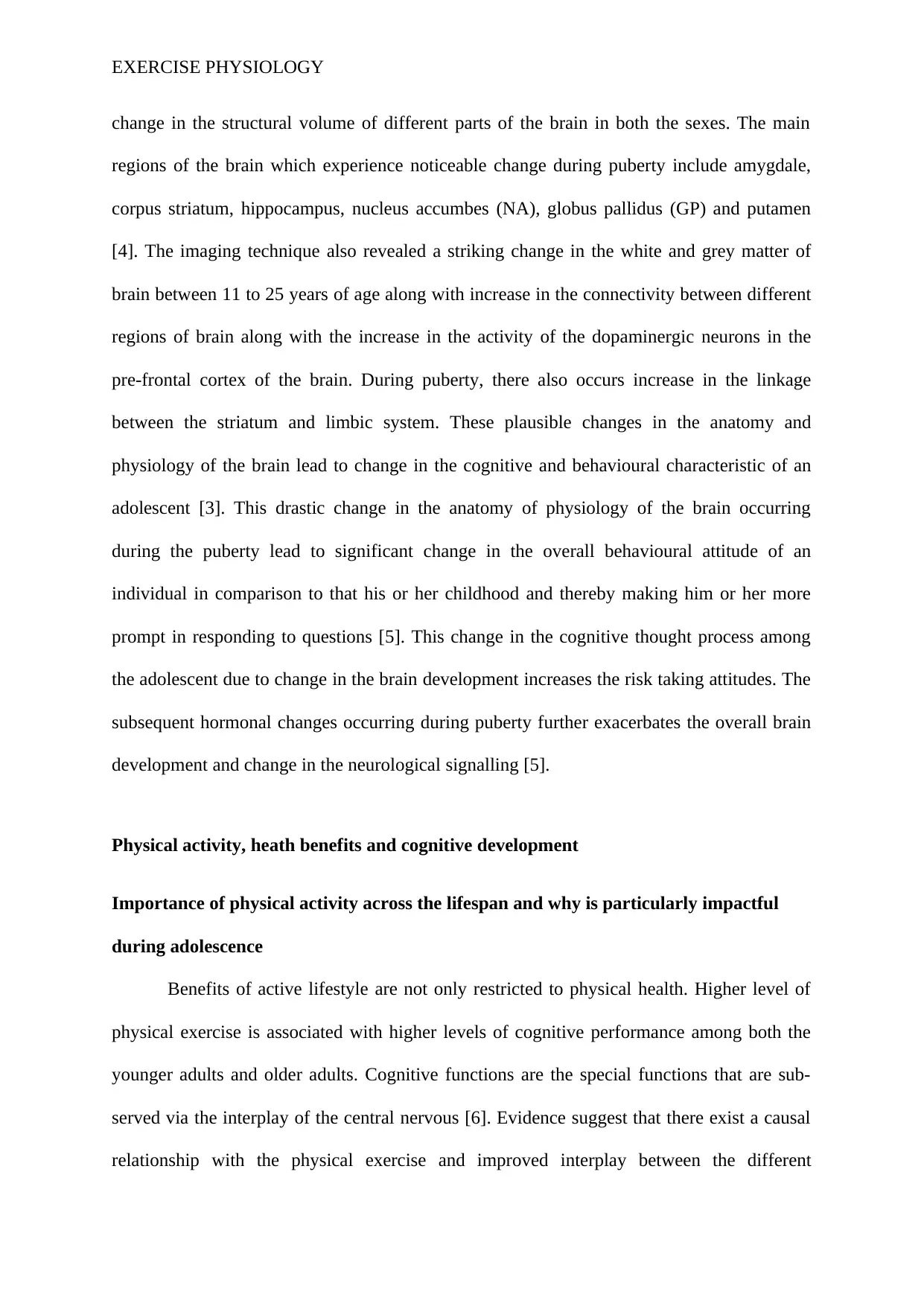
EXERCISE PHYSIOLOGY
change in the structural volume of different parts of the brain in both the sexes. The main
regions of the brain which experience noticeable change during puberty include amygdale,
corpus striatum, hippocampus, nucleus accumbes (NA), globus pallidus (GP) and putamen
[4]. The imaging technique also revealed a striking change in the white and grey matter of
brain between 11 to 25 years of age along with increase in the connectivity between different
regions of brain along with the increase in the activity of the dopaminergic neurons in the
pre-frontal cortex of the brain. During puberty, there also occurs increase in the linkage
between the striatum and limbic system. These plausible changes in the anatomy and
physiology of the brain lead to change in the cognitive and behavioural characteristic of an
adolescent [3]. This drastic change in the anatomy of physiology of the brain occurring
during the puberty lead to significant change in the overall behavioural attitude of an
individual in comparison to that his or her childhood and thereby making him or her more
prompt in responding to questions [5]. This change in the cognitive thought process among
the adolescent due to change in the brain development increases the risk taking attitudes. The
subsequent hormonal changes occurring during puberty further exacerbates the overall brain
development and change in the neurological signalling [5].
Physical activity, heath benefits and cognitive development
Importance of physical activity across the lifespan and why is particularly impactful
during adolescence
Benefits of active lifestyle are not only restricted to physical health. Higher level of
physical exercise is associated with higher levels of cognitive performance among both the
younger adults and older adults. Cognitive functions are the special functions that are sub-
served via the interplay of the central nervous [6]. Evidence suggest that there exist a causal
relationship with the physical exercise and improved interplay between the different
change in the structural volume of different parts of the brain in both the sexes. The main
regions of the brain which experience noticeable change during puberty include amygdale,
corpus striatum, hippocampus, nucleus accumbes (NA), globus pallidus (GP) and putamen
[4]. The imaging technique also revealed a striking change in the white and grey matter of
brain between 11 to 25 years of age along with increase in the connectivity between different
regions of brain along with the increase in the activity of the dopaminergic neurons in the
pre-frontal cortex of the brain. During puberty, there also occurs increase in the linkage
between the striatum and limbic system. These plausible changes in the anatomy and
physiology of the brain lead to change in the cognitive and behavioural characteristic of an
adolescent [3]. This drastic change in the anatomy of physiology of the brain occurring
during the puberty lead to significant change in the overall behavioural attitude of an
individual in comparison to that his or her childhood and thereby making him or her more
prompt in responding to questions [5]. This change in the cognitive thought process among
the adolescent due to change in the brain development increases the risk taking attitudes. The
subsequent hormonal changes occurring during puberty further exacerbates the overall brain
development and change in the neurological signalling [5].
Physical activity, heath benefits and cognitive development
Importance of physical activity across the lifespan and why is particularly impactful
during adolescence
Benefits of active lifestyle are not only restricted to physical health. Higher level of
physical exercise is associated with higher levels of cognitive performance among both the
younger adults and older adults. Cognitive functions are the special functions that are sub-
served via the interplay of the central nervous [6]. Evidence suggest that there exist a causal
relationship with the physical exercise and improved interplay between the different
⊘ This is a preview!⊘
Do you want full access?
Subscribe today to unlock all pages.

Trusted by 1+ million students worldwide
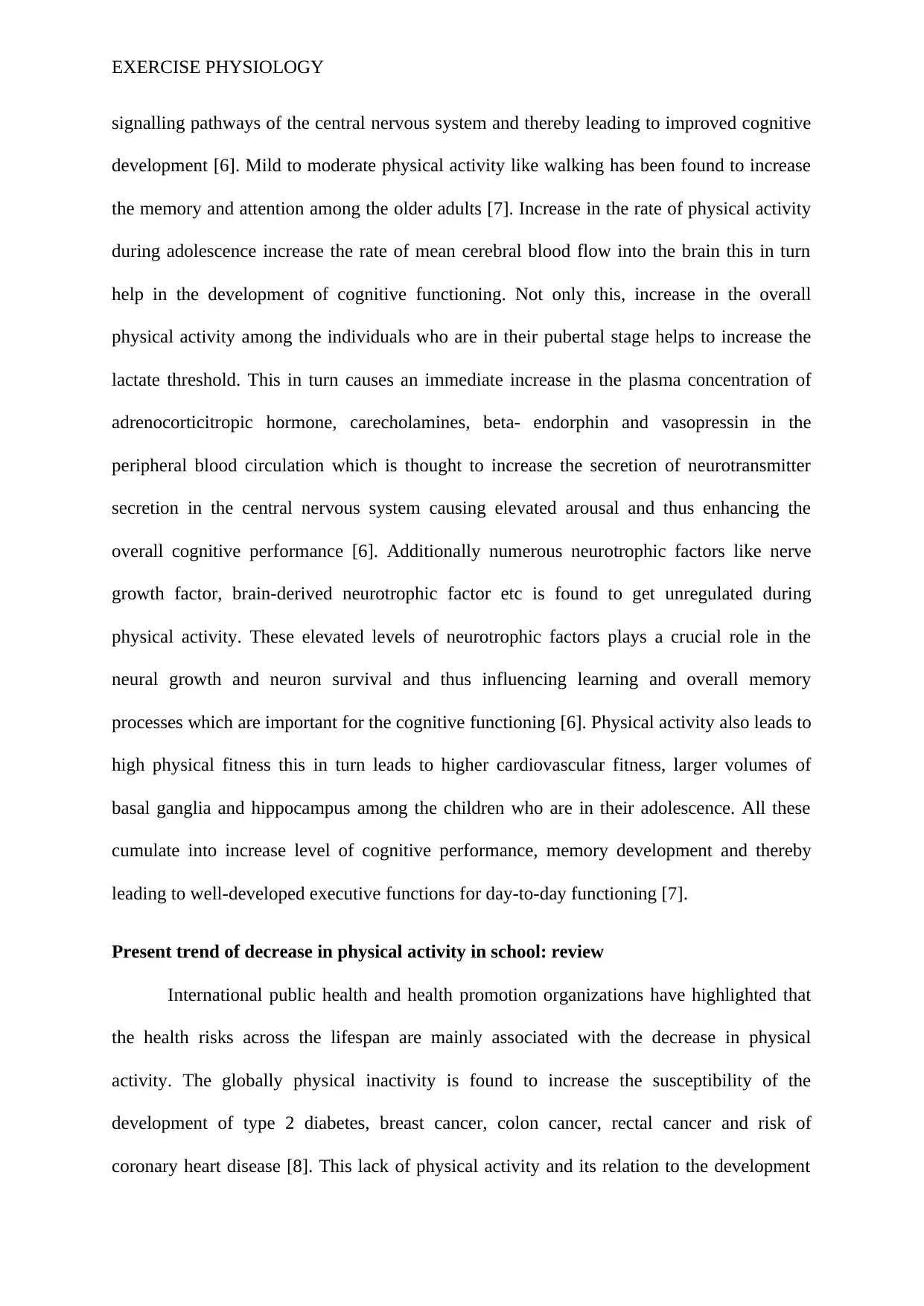
EXERCISE PHYSIOLOGY
signalling pathways of the central nervous system and thereby leading to improved cognitive
development [6]. Mild to moderate physical activity like walking has been found to increase
the memory and attention among the older adults [7]. Increase in the rate of physical activity
during adolescence increase the rate of mean cerebral blood flow into the brain this in turn
help in the development of cognitive functioning. Not only this, increase in the overall
physical activity among the individuals who are in their pubertal stage helps to increase the
lactate threshold. This in turn causes an immediate increase in the plasma concentration of
adrenocorticitropic hormone, carecholamines, beta- endorphin and vasopressin in the
peripheral blood circulation which is thought to increase the secretion of neurotransmitter
secretion in the central nervous system causing elevated arousal and thus enhancing the
overall cognitive performance [6]. Additionally numerous neurotrophic factors like nerve
growth factor, brain-derived neurotrophic factor etc is found to get unregulated during
physical activity. These elevated levels of neurotrophic factors plays a crucial role in the
neural growth and neuron survival and thus influencing learning and overall memory
processes which are important for the cognitive functioning [6]. Physical activity also leads to
high physical fitness this in turn leads to higher cardiovascular fitness, larger volumes of
basal ganglia and hippocampus among the children who are in their adolescence. All these
cumulate into increase level of cognitive performance, memory development and thereby
leading to well-developed executive functions for day-to-day functioning [7].
Present trend of decrease in physical activity in school: review
International public health and health promotion organizations have highlighted that
the health risks across the lifespan are mainly associated with the decrease in physical
activity. The globally physical inactivity is found to increase the susceptibility of the
development of type 2 diabetes, breast cancer, colon cancer, rectal cancer and risk of
coronary heart disease [8]. This lack of physical activity and its relation to the development
signalling pathways of the central nervous system and thereby leading to improved cognitive
development [6]. Mild to moderate physical activity like walking has been found to increase
the memory and attention among the older adults [7]. Increase in the rate of physical activity
during adolescence increase the rate of mean cerebral blood flow into the brain this in turn
help in the development of cognitive functioning. Not only this, increase in the overall
physical activity among the individuals who are in their pubertal stage helps to increase the
lactate threshold. This in turn causes an immediate increase in the plasma concentration of
adrenocorticitropic hormone, carecholamines, beta- endorphin and vasopressin in the
peripheral blood circulation which is thought to increase the secretion of neurotransmitter
secretion in the central nervous system causing elevated arousal and thus enhancing the
overall cognitive performance [6]. Additionally numerous neurotrophic factors like nerve
growth factor, brain-derived neurotrophic factor etc is found to get unregulated during
physical activity. These elevated levels of neurotrophic factors plays a crucial role in the
neural growth and neuron survival and thus influencing learning and overall memory
processes which are important for the cognitive functioning [6]. Physical activity also leads to
high physical fitness this in turn leads to higher cardiovascular fitness, larger volumes of
basal ganglia and hippocampus among the children who are in their adolescence. All these
cumulate into increase level of cognitive performance, memory development and thereby
leading to well-developed executive functions for day-to-day functioning [7].
Present trend of decrease in physical activity in school: review
International public health and health promotion organizations have highlighted that
the health risks across the lifespan are mainly associated with the decrease in physical
activity. The globally physical inactivity is found to increase the susceptibility of the
development of type 2 diabetes, breast cancer, colon cancer, rectal cancer and risk of
coronary heart disease [8]. This lack of physical activity and its relation to the development
Paraphrase This Document
Need a fresh take? Get an instant paraphrase of this document with our AI Paraphraser
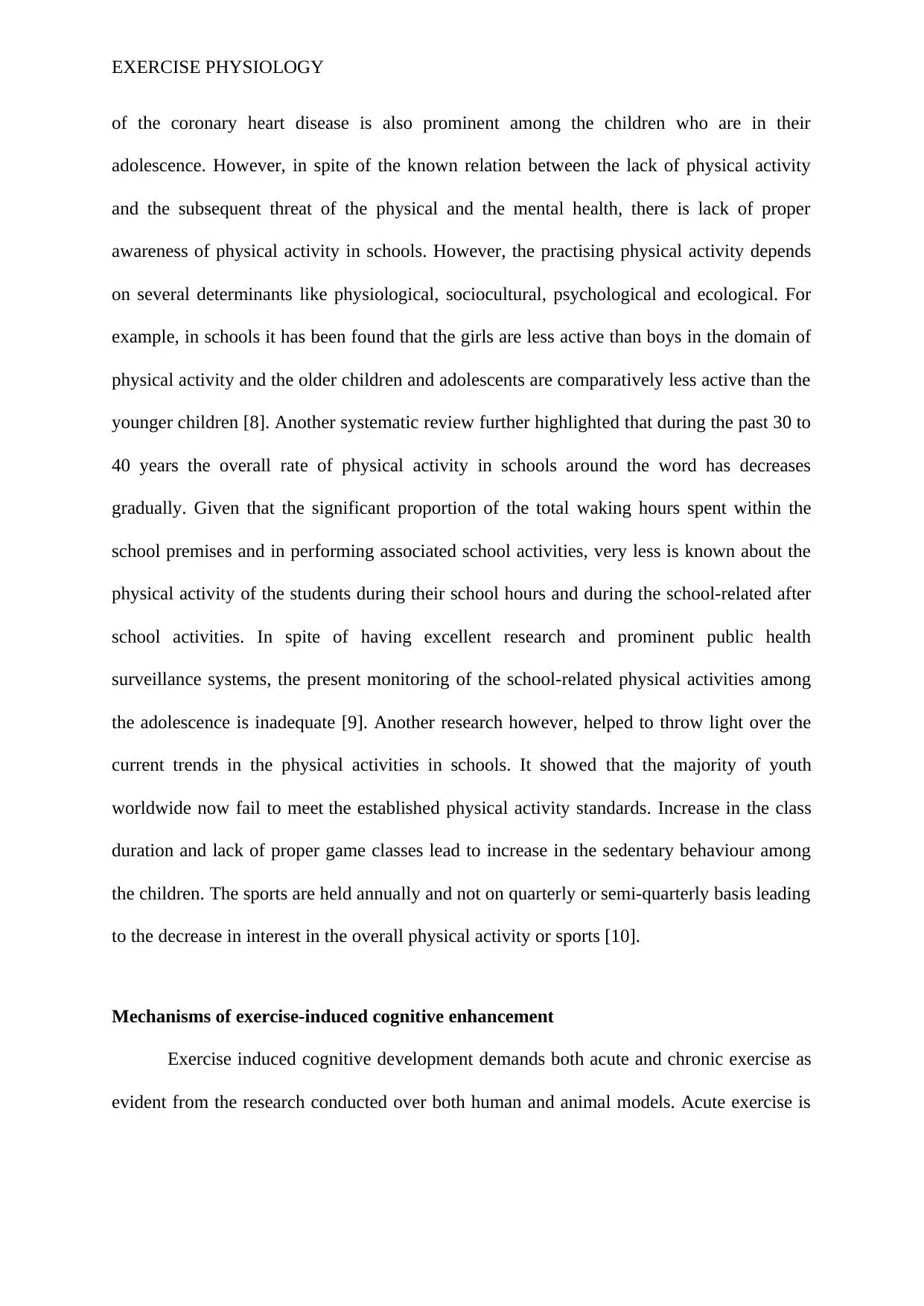
EXERCISE PHYSIOLOGY
of the coronary heart disease is also prominent among the children who are in their
adolescence. However, in spite of the known relation between the lack of physical activity
and the subsequent threat of the physical and the mental health, there is lack of proper
awareness of physical activity in schools. However, the practising physical activity depends
on several determinants like physiological, sociocultural, psychological and ecological. For
example, in schools it has been found that the girls are less active than boys in the domain of
physical activity and the older children and adolescents are comparatively less active than the
younger children [8]. Another systematic review further highlighted that during the past 30 to
40 years the overall rate of physical activity in schools around the word has decreases
gradually. Given that the significant proportion of the total waking hours spent within the
school premises and in performing associated school activities, very less is known about the
physical activity of the students during their school hours and during the school-related after
school activities. In spite of having excellent research and prominent public health
surveillance systems, the present monitoring of the school-related physical activities among
the adolescence is inadequate [9]. Another research however, helped to throw light over the
current trends in the physical activities in schools. It showed that the majority of youth
worldwide now fail to meet the established physical activity standards. Increase in the class
duration and lack of proper game classes lead to increase in the sedentary behaviour among
the children. The sports are held annually and not on quarterly or semi-quarterly basis leading
to the decrease in interest in the overall physical activity or sports [10].
Mechanisms of exercise-induced cognitive enhancement
Exercise induced cognitive development demands both acute and chronic exercise as
evident from the research conducted over both human and animal models. Acute exercise is
of the coronary heart disease is also prominent among the children who are in their
adolescence. However, in spite of the known relation between the lack of physical activity
and the subsequent threat of the physical and the mental health, there is lack of proper
awareness of physical activity in schools. However, the practising physical activity depends
on several determinants like physiological, sociocultural, psychological and ecological. For
example, in schools it has been found that the girls are less active than boys in the domain of
physical activity and the older children and adolescents are comparatively less active than the
younger children [8]. Another systematic review further highlighted that during the past 30 to
40 years the overall rate of physical activity in schools around the word has decreases
gradually. Given that the significant proportion of the total waking hours spent within the
school premises and in performing associated school activities, very less is known about the
physical activity of the students during their school hours and during the school-related after
school activities. In spite of having excellent research and prominent public health
surveillance systems, the present monitoring of the school-related physical activities among
the adolescence is inadequate [9]. Another research however, helped to throw light over the
current trends in the physical activities in schools. It showed that the majority of youth
worldwide now fail to meet the established physical activity standards. Increase in the class
duration and lack of proper game classes lead to increase in the sedentary behaviour among
the children. The sports are held annually and not on quarterly or semi-quarterly basis leading
to the decrease in interest in the overall physical activity or sports [10].
Mechanisms of exercise-induced cognitive enhancement
Exercise induced cognitive development demands both acute and chronic exercise as
evident from the research conducted over both human and animal models. Acute exercise is
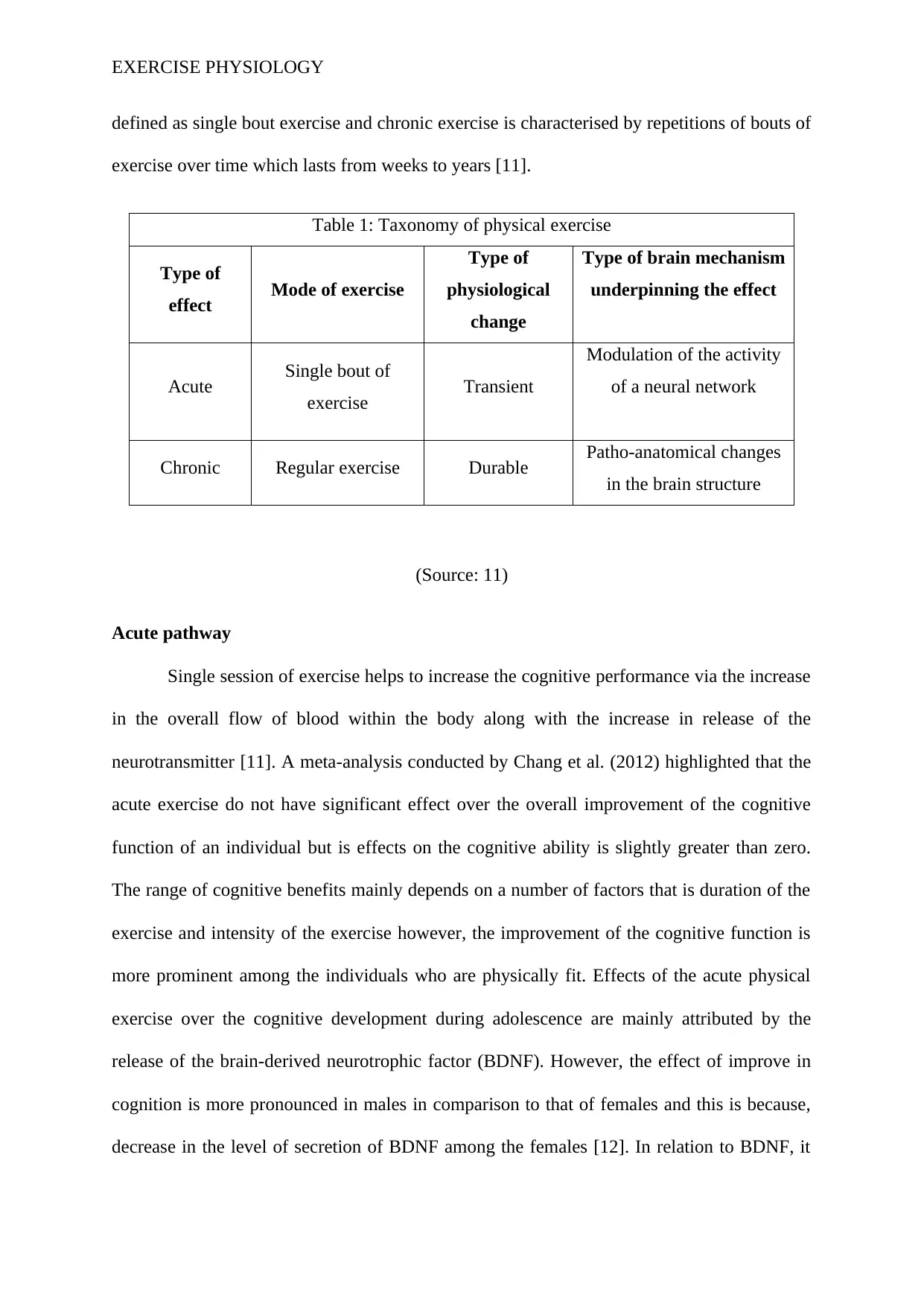
EXERCISE PHYSIOLOGY
defined as single bout exercise and chronic exercise is characterised by repetitions of bouts of
exercise over time which lasts from weeks to years [11].
Table 1: Taxonomy of physical exercise
Type of
effect Mode of exercise
Type of
physiological
change
Type of brain mechanism
underpinning the effect
Acute Single bout of
exercise Transient
Modulation of the activity
of a neural network
Chronic Regular exercise Durable Patho-anatomical changes
in the brain structure
(Source: 11)
Acute pathway
Single session of exercise helps to increase the cognitive performance via the increase
in the overall flow of blood within the body along with the increase in release of the
neurotransmitter [11]. A meta-analysis conducted by Chang et al. (2012) highlighted that the
acute exercise do not have significant effect over the overall improvement of the cognitive
function of an individual but is effects on the cognitive ability is slightly greater than zero.
The range of cognitive benefits mainly depends on a number of factors that is duration of the
exercise and intensity of the exercise however, the improvement of the cognitive function is
more prominent among the individuals who are physically fit. Effects of the acute physical
exercise over the cognitive development during adolescence are mainly attributed by the
release of the brain-derived neurotrophic factor (BDNF). However, the effect of improve in
cognition is more pronounced in males in comparison to that of females and this is because,
decrease in the level of secretion of BDNF among the females [12]. In relation to BDNF, it
defined as single bout exercise and chronic exercise is characterised by repetitions of bouts of
exercise over time which lasts from weeks to years [11].
Table 1: Taxonomy of physical exercise
Type of
effect Mode of exercise
Type of
physiological
change
Type of brain mechanism
underpinning the effect
Acute Single bout of
exercise Transient
Modulation of the activity
of a neural network
Chronic Regular exercise Durable Patho-anatomical changes
in the brain structure
(Source: 11)
Acute pathway
Single session of exercise helps to increase the cognitive performance via the increase
in the overall flow of blood within the body along with the increase in release of the
neurotransmitter [11]. A meta-analysis conducted by Chang et al. (2012) highlighted that the
acute exercise do not have significant effect over the overall improvement of the cognitive
function of an individual but is effects on the cognitive ability is slightly greater than zero.
The range of cognitive benefits mainly depends on a number of factors that is duration of the
exercise and intensity of the exercise however, the improvement of the cognitive function is
more prominent among the individuals who are physically fit. Effects of the acute physical
exercise over the cognitive development during adolescence are mainly attributed by the
release of the brain-derived neurotrophic factor (BDNF). However, the effect of improve in
cognition is more pronounced in males in comparison to that of females and this is because,
decrease in the level of secretion of BDNF among the females [12]. In relation to BDNF, it
⊘ This is a preview!⊘
Do you want full access?
Subscribe today to unlock all pages.

Trusted by 1+ million students worldwide
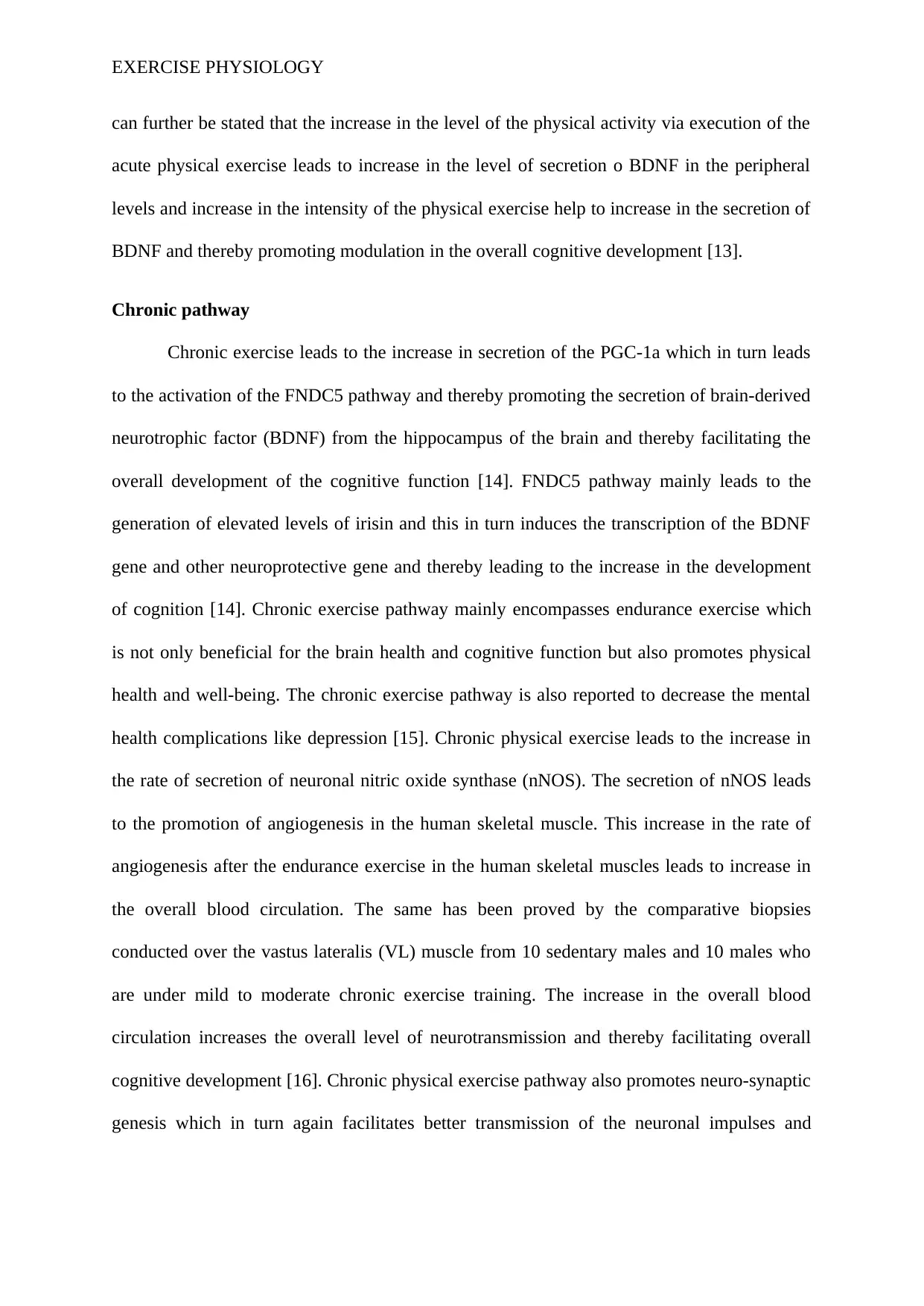
EXERCISE PHYSIOLOGY
can further be stated that the increase in the level of the physical activity via execution of the
acute physical exercise leads to increase in the level of secretion o BDNF in the peripheral
levels and increase in the intensity of the physical exercise help to increase in the secretion of
BDNF and thereby promoting modulation in the overall cognitive development [13].
Chronic pathway
Chronic exercise leads to the increase in secretion of the PGC-1a which in turn leads
to the activation of the FNDC5 pathway and thereby promoting the secretion of brain-derived
neurotrophic factor (BDNF) from the hippocampus of the brain and thereby facilitating the
overall development of the cognitive function [14]. FNDC5 pathway mainly leads to the
generation of elevated levels of irisin and this in turn induces the transcription of the BDNF
gene and other neuroprotective gene and thereby leading to the increase in the development
of cognition [14]. Chronic exercise pathway mainly encompasses endurance exercise which
is not only beneficial for the brain health and cognitive function but also promotes physical
health and well-being. The chronic exercise pathway is also reported to decrease the mental
health complications like depression [15]. Chronic physical exercise leads to the increase in
the rate of secretion of neuronal nitric oxide synthase (nNOS). The secretion of nNOS leads
to the promotion of angiogenesis in the human skeletal muscle. This increase in the rate of
angiogenesis after the endurance exercise in the human skeletal muscles leads to increase in
the overall blood circulation. The same has been proved by the comparative biopsies
conducted over the vastus lateralis (VL) muscle from 10 sedentary males and 10 males who
are under mild to moderate chronic exercise training. The increase in the overall blood
circulation increases the overall level of neurotransmission and thereby facilitating overall
cognitive development [16]. Chronic physical exercise pathway also promotes neuro-synaptic
genesis which in turn again facilitates better transmission of the neuronal impulses and
can further be stated that the increase in the level of the physical activity via execution of the
acute physical exercise leads to increase in the level of secretion o BDNF in the peripheral
levels and increase in the intensity of the physical exercise help to increase in the secretion of
BDNF and thereby promoting modulation in the overall cognitive development [13].
Chronic pathway
Chronic exercise leads to the increase in secretion of the PGC-1a which in turn leads
to the activation of the FNDC5 pathway and thereby promoting the secretion of brain-derived
neurotrophic factor (BDNF) from the hippocampus of the brain and thereby facilitating the
overall development of the cognitive function [14]. FNDC5 pathway mainly leads to the
generation of elevated levels of irisin and this in turn induces the transcription of the BDNF
gene and other neuroprotective gene and thereby leading to the increase in the development
of cognition [14]. Chronic exercise pathway mainly encompasses endurance exercise which
is not only beneficial for the brain health and cognitive function but also promotes physical
health and well-being. The chronic exercise pathway is also reported to decrease the mental
health complications like depression [15]. Chronic physical exercise leads to the increase in
the rate of secretion of neuronal nitric oxide synthase (nNOS). The secretion of nNOS leads
to the promotion of angiogenesis in the human skeletal muscle. This increase in the rate of
angiogenesis after the endurance exercise in the human skeletal muscles leads to increase in
the overall blood circulation. The same has been proved by the comparative biopsies
conducted over the vastus lateralis (VL) muscle from 10 sedentary males and 10 males who
are under mild to moderate chronic exercise training. The increase in the overall blood
circulation increases the overall level of neurotransmission and thereby facilitating overall
cognitive development [16]. Chronic physical exercise pathway also promotes neuro-synaptic
genesis which in turn again facilitates better transmission of the neuronal impulses and
Paraphrase This Document
Need a fresh take? Get an instant paraphrase of this document with our AI Paraphraser

EXERCISE PHYSIOLOGY
thereby helping the population who are in their adolescences who improve on their cognitive
functions [17].
thereby helping the population who are in their adolescences who improve on their cognitive
functions [17].
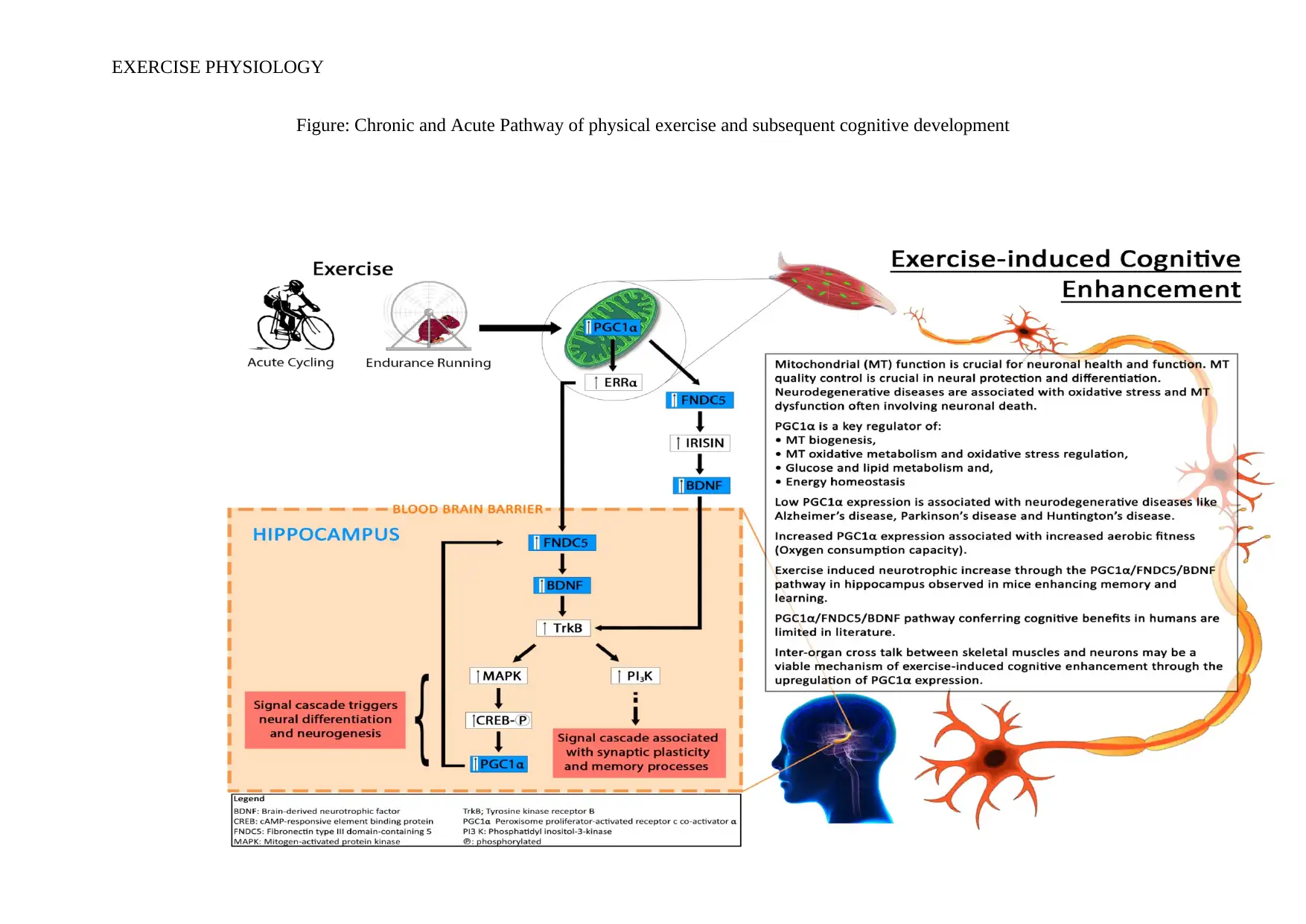
EXERCISE PHYSIOLOGY
Figure: Chronic and Acute Pathway of physical exercise and subsequent cognitive development
Figure: Chronic and Acute Pathway of physical exercise and subsequent cognitive development
⊘ This is a preview!⊘
Do you want full access?
Subscribe today to unlock all pages.

Trusted by 1+ million students worldwide
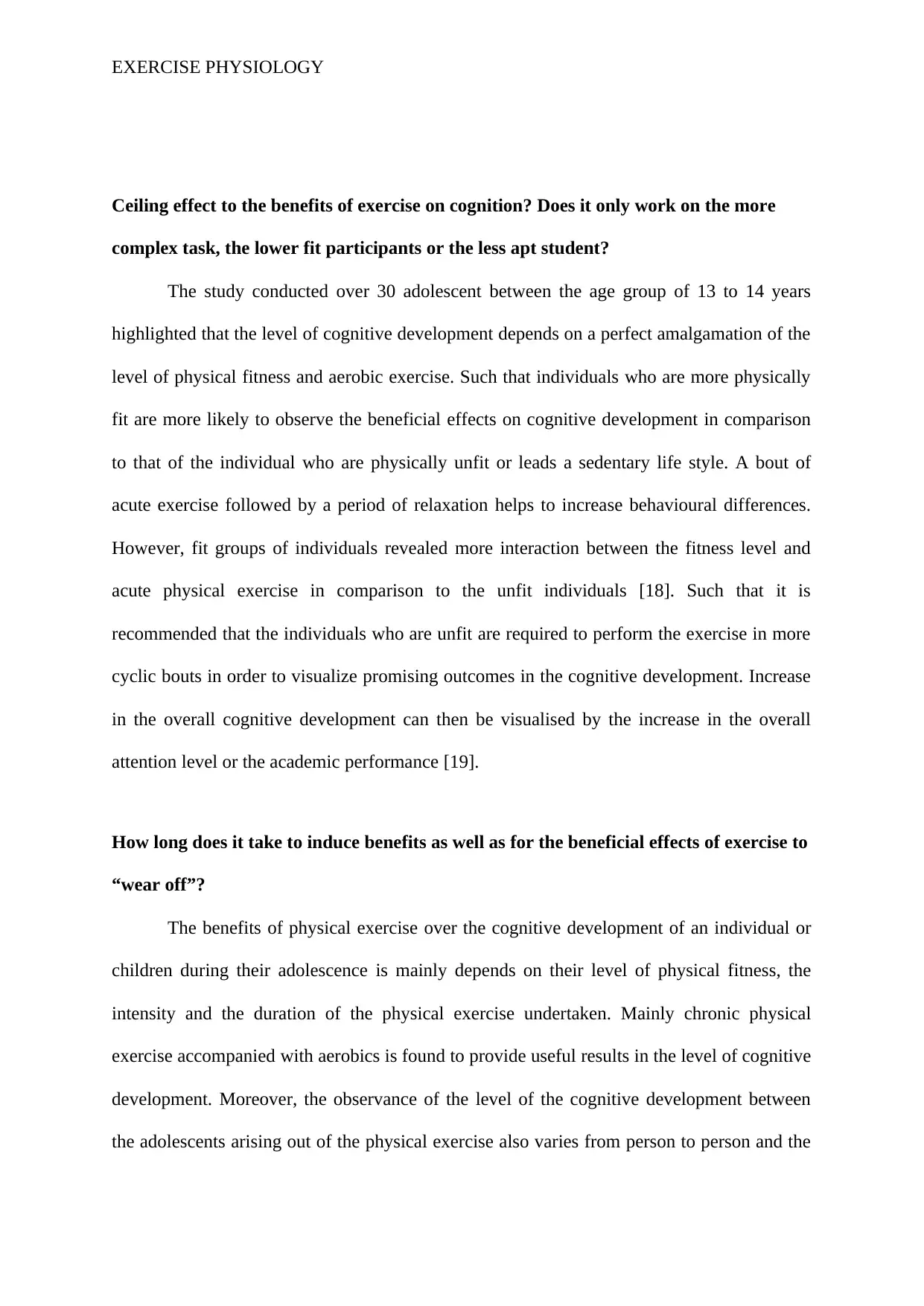
EXERCISE PHYSIOLOGY
Ceiling effect to the benefits of exercise on cognition? Does it only work on the more
complex task, the lower fit participants or the less apt student?
The study conducted over 30 adolescent between the age group of 13 to 14 years
highlighted that the level of cognitive development depends on a perfect amalgamation of the
level of physical fitness and aerobic exercise. Such that individuals who are more physically
fit are more likely to observe the beneficial effects on cognitive development in comparison
to that of the individual who are physically unfit or leads a sedentary life style. A bout of
acute exercise followed by a period of relaxation helps to increase behavioural differences.
However, fit groups of individuals revealed more interaction between the fitness level and
acute physical exercise in comparison to the unfit individuals [18]. Such that it is
recommended that the individuals who are unfit are required to perform the exercise in more
cyclic bouts in order to visualize promising outcomes in the cognitive development. Increase
in the overall cognitive development can then be visualised by the increase in the overall
attention level or the academic performance [19].
How long does it take to induce benefits as well as for the beneficial effects of exercise to
“wear off”?
The benefits of physical exercise over the cognitive development of an individual or
children during their adolescence is mainly depends on their level of physical fitness, the
intensity and the duration of the physical exercise undertaken. Mainly chronic physical
exercise accompanied with aerobics is found to provide useful results in the level of cognitive
development. Moreover, the observance of the level of the cognitive development between
the adolescents arising out of the physical exercise also varies from person to person and the
Ceiling effect to the benefits of exercise on cognition? Does it only work on the more
complex task, the lower fit participants or the less apt student?
The study conducted over 30 adolescent between the age group of 13 to 14 years
highlighted that the level of cognitive development depends on a perfect amalgamation of the
level of physical fitness and aerobic exercise. Such that individuals who are more physically
fit are more likely to observe the beneficial effects on cognitive development in comparison
to that of the individual who are physically unfit or leads a sedentary life style. A bout of
acute exercise followed by a period of relaxation helps to increase behavioural differences.
However, fit groups of individuals revealed more interaction between the fitness level and
acute physical exercise in comparison to the unfit individuals [18]. Such that it is
recommended that the individuals who are unfit are required to perform the exercise in more
cyclic bouts in order to visualize promising outcomes in the cognitive development. Increase
in the overall cognitive development can then be visualised by the increase in the overall
attention level or the academic performance [19].
How long does it take to induce benefits as well as for the beneficial effects of exercise to
“wear off”?
The benefits of physical exercise over the cognitive development of an individual or
children during their adolescence is mainly depends on their level of physical fitness, the
intensity and the duration of the physical exercise undertaken. Mainly chronic physical
exercise accompanied with aerobics is found to provide useful results in the level of cognitive
development. Moreover, the observance of the level of the cognitive development between
the adolescents arising out of the physical exercise also varies from person to person and the
Paraphrase This Document
Need a fresh take? Get an instant paraphrase of this document with our AI Paraphraser
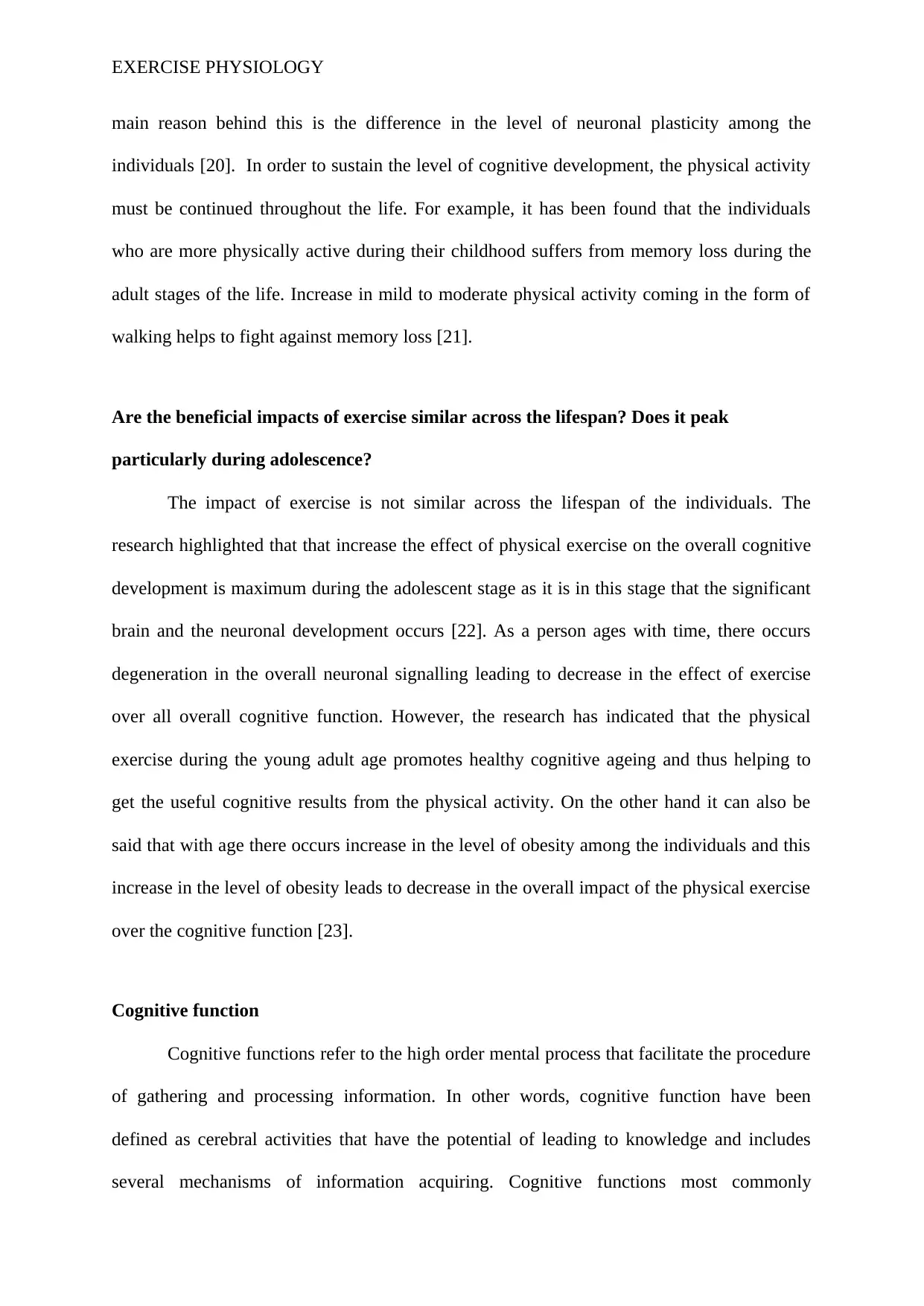
EXERCISE PHYSIOLOGY
main reason behind this is the difference in the level of neuronal plasticity among the
individuals [20]. In order to sustain the level of cognitive development, the physical activity
must be continued throughout the life. For example, it has been found that the individuals
who are more physically active during their childhood suffers from memory loss during the
adult stages of the life. Increase in mild to moderate physical activity coming in the form of
walking helps to fight against memory loss [21].
Are the beneficial impacts of exercise similar across the lifespan? Does it peak
particularly during adolescence?
The impact of exercise is not similar across the lifespan of the individuals. The
research highlighted that that increase the effect of physical exercise on the overall cognitive
development is maximum during the adolescent stage as it is in this stage that the significant
brain and the neuronal development occurs [22]. As a person ages with time, there occurs
degeneration in the overall neuronal signalling leading to decrease in the effect of exercise
over all overall cognitive function. However, the research has indicated that the physical
exercise during the young adult age promotes healthy cognitive ageing and thus helping to
get the useful cognitive results from the physical activity. On the other hand it can also be
said that with age there occurs increase in the level of obesity among the individuals and this
increase in the level of obesity leads to decrease in the overall impact of the physical exercise
over the cognitive function [23].
Cognitive function
Cognitive functions refer to the high order mental process that facilitate the procedure
of gathering and processing information. In other words, cognitive function have been
defined as cerebral activities that have the potential of leading to knowledge and includes
several mechanisms of information acquiring. Cognitive functions most commonly
main reason behind this is the difference in the level of neuronal plasticity among the
individuals [20]. In order to sustain the level of cognitive development, the physical activity
must be continued throughout the life. For example, it has been found that the individuals
who are more physically active during their childhood suffers from memory loss during the
adult stages of the life. Increase in mild to moderate physical activity coming in the form of
walking helps to fight against memory loss [21].
Are the beneficial impacts of exercise similar across the lifespan? Does it peak
particularly during adolescence?
The impact of exercise is not similar across the lifespan of the individuals. The
research highlighted that that increase the effect of physical exercise on the overall cognitive
development is maximum during the adolescent stage as it is in this stage that the significant
brain and the neuronal development occurs [22]. As a person ages with time, there occurs
degeneration in the overall neuronal signalling leading to decrease in the effect of exercise
over all overall cognitive function. However, the research has indicated that the physical
exercise during the young adult age promotes healthy cognitive ageing and thus helping to
get the useful cognitive results from the physical activity. On the other hand it can also be
said that with age there occurs increase in the level of obesity among the individuals and this
increase in the level of obesity leads to decrease in the overall impact of the physical exercise
over the cognitive function [23].
Cognitive function
Cognitive functions refer to the high order mental process that facilitate the procedure
of gathering and processing information. In other words, cognitive function have been
defined as cerebral activities that have the potential of leading to knowledge and includes
several mechanisms of information acquiring. Cognitive functions most commonly
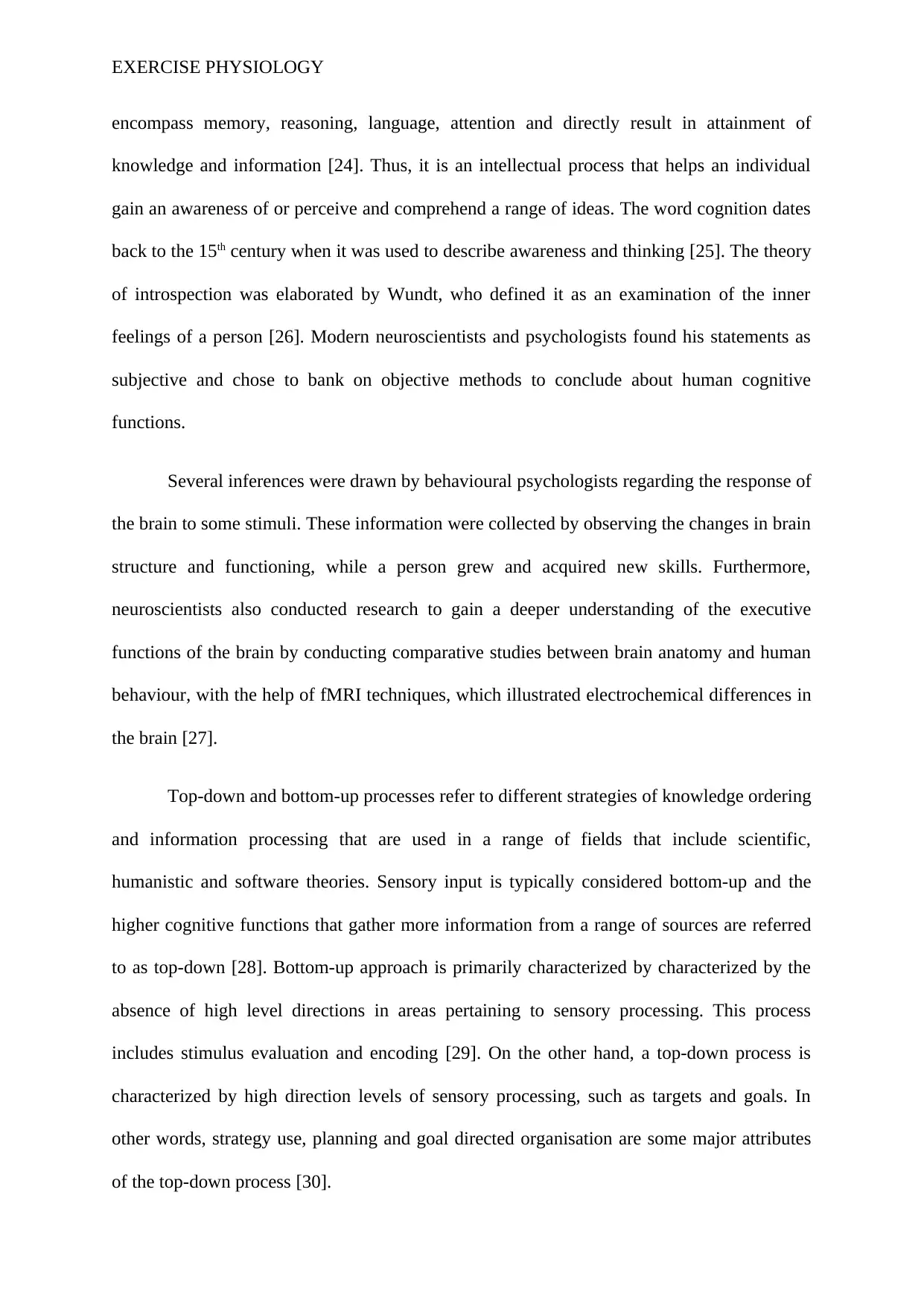
EXERCISE PHYSIOLOGY
encompass memory, reasoning, language, attention and directly result in attainment of
knowledge and information [24]. Thus, it is an intellectual process that helps an individual
gain an awareness of or perceive and comprehend a range of ideas. The word cognition dates
back to the 15th century when it was used to describe awareness and thinking [25]. The theory
of introspection was elaborated by Wundt, who defined it as an examination of the inner
feelings of a person [26]. Modern neuroscientists and psychologists found his statements as
subjective and chose to bank on objective methods to conclude about human cognitive
functions.
Several inferences were drawn by behavioural psychologists regarding the response of
the brain to some stimuli. These information were collected by observing the changes in brain
structure and functioning, while a person grew and acquired new skills. Furthermore,
neuroscientists also conducted research to gain a deeper understanding of the executive
functions of the brain by conducting comparative studies between brain anatomy and human
behaviour, with the help of fMRI techniques, which illustrated electrochemical differences in
the brain [27].
Top-down and bottom-up processes refer to different strategies of knowledge ordering
and information processing that are used in a range of fields that include scientific,
humanistic and software theories. Sensory input is typically considered bottom-up and the
higher cognitive functions that gather more information from a range of sources are referred
to as top-down [28]. Bottom-up approach is primarily characterized by characterized by the
absence of high level directions in areas pertaining to sensory processing. This process
includes stimulus evaluation and encoding [29]. On the other hand, a top-down process is
characterized by high direction levels of sensory processing, such as targets and goals. In
other words, strategy use, planning and goal directed organisation are some major attributes
of the top-down process [30].
encompass memory, reasoning, language, attention and directly result in attainment of
knowledge and information [24]. Thus, it is an intellectual process that helps an individual
gain an awareness of or perceive and comprehend a range of ideas. The word cognition dates
back to the 15th century when it was used to describe awareness and thinking [25]. The theory
of introspection was elaborated by Wundt, who defined it as an examination of the inner
feelings of a person [26]. Modern neuroscientists and psychologists found his statements as
subjective and chose to bank on objective methods to conclude about human cognitive
functions.
Several inferences were drawn by behavioural psychologists regarding the response of
the brain to some stimuli. These information were collected by observing the changes in brain
structure and functioning, while a person grew and acquired new skills. Furthermore,
neuroscientists also conducted research to gain a deeper understanding of the executive
functions of the brain by conducting comparative studies between brain anatomy and human
behaviour, with the help of fMRI techniques, which illustrated electrochemical differences in
the brain [27].
Top-down and bottom-up processes refer to different strategies of knowledge ordering
and information processing that are used in a range of fields that include scientific,
humanistic and software theories. Sensory input is typically considered bottom-up and the
higher cognitive functions that gather more information from a range of sources are referred
to as top-down [28]. Bottom-up approach is primarily characterized by characterized by the
absence of high level directions in areas pertaining to sensory processing. This process
includes stimulus evaluation and encoding [29]. On the other hand, a top-down process is
characterized by high direction levels of sensory processing, such as targets and goals. In
other words, strategy use, planning and goal directed organisation are some major attributes
of the top-down process [30].
⊘ This is a preview!⊘
Do you want full access?
Subscribe today to unlock all pages.

Trusted by 1+ million students worldwide
1 out of 31
Related Documents
Your All-in-One AI-Powered Toolkit for Academic Success.
+13062052269
info@desklib.com
Available 24*7 on WhatsApp / Email
![[object Object]](/_next/static/media/star-bottom.7253800d.svg)
Unlock your academic potential
Copyright © 2020–2025 A2Z Services. All Rights Reserved. Developed and managed by ZUCOL.




